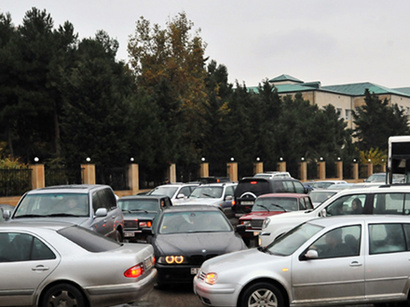Number of cars expected to nearly double in Greater Baku area by 2030

By Nigar Orujova
Automobilization in the Greater Baku area will nearly double by 2030, according to the Greater Baku Regional Development Plan draft, which is currently under discussion in relevant government agencies of Azerbaijan.
At present, there are 250 cars per 1,000 people in the Greater Baku area, or the territory of Baku, Sumgayit and Absheron Peninsula. The figure is expected to reach 480 cars per 1,000 people by 2030, the draft says.
Currently, Greater Baku has 1.62 car trips per person a day, and it is expected that by 2030 this figure will reach 2.5 trips.
2,231 million trips a day are made by public transport, and 2 million trips by privately owned vehicles.
According to the forecast for 2030, traffic in the area will be used daily 9.46 million times, of which over 6.5 million trips will be made by public transport, and nearly 3 million by private vehicles.
Taking into consideration the forecasted population growth by 1.52 times in Greater Baku, as well as the growth of the economy, household income and the number of cars, by 2030 the demand for the use of transport will increase by 2.23 times, according to the draft project.
Thus, with the current conditions, traffic jams are expected to occur on all the major roads in the capital Baku.
The basic traffic load is expected on such avenues as Tbilisi, Ziya Bunyadov, and Nobel, with the load to increase in the northern part of the city in the area between the Absheron district, Sumgayit city and Sabunchi district, as well as on the new road junctions, which will be constructed in the directions from west to east.
The draft says that the link between Tbilisi Avenue and the International Bus Station is also difficult. The transportation corridor along the Sumgayit main road should be designed for 435,000 passengers per day by 2030. Passenger traffic will reach 630,000 people a day in some specific areas of Tbilisi Avenue. Another important transport corridor is the Baku-Sabunchi-Khazar corridor.
Earlier, head of the group executing the Greater Baku development project, Novruz Eldarli, said the Plan involves the introduction of new types of public transport. "Currently it is necessary to effectively implement new types of public transport in Baku - light rail, skytrains, metrobuses, etc. Road construction within the city and beyond is proposed, particularly from Baku to the Heydar Aliyev International Airport, Sumgayit and Alat [a settlement near the capital city]," Eldarli said.
The project envisions the development and modernization of public transport, the expansion of its network, improving its quality, convenience, and improved access to it. The project also provides for the development of the road network in Baku.
Azerbaijan and the World Bank signed a loan agreement in 2007 to develop the Greater Baku Regional Development Plan. The plan has been developed through coordination with Baku State Design Institute.
According to preliminary estimates, the average cost of the Plan may reach 4-5 billion manats (over $6.3 billion).
The Plan envisions future development of the city with its 11 surrounding areas, Sumgayit, the country's third largest city, and the entire Absheron Peninsula by 2030. The plan is scheduled to be approved by the year-end.
Here we are to serve you with news right now. It does not cost much, but worth your attention.
Choose to support open, independent, quality journalism and subscribe on a monthly basis.
By subscribing to our online newspaper, you can have full digital access to all news, analysis, and much more.
You can also follow AzerNEWS on Twitter @AzerNewsAz or Facebook @AzerNewsNewspaper
Thank you!
